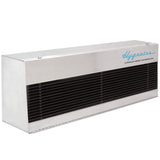Ultraviolet UVC Lighting for Hospitals and Patient Rooms
Posted by Nick on for ProLampSales

Since the COVID-19 crisis hit the United States, interest in ultraviolet UVC irradiation for disinfection has skyrocketed. Many homeowners and businesses have bought portable and handheld devices, or replaced the UV bulbs in their existing equipment.
For hospitals and medical facilities, however, ultraviolet germicidal irradiation (UVGI) is much more complicated, and the shortage of N95 masks, gloves, ventilators, and other equipment has only contributed to the need for non-disposable, non-chemical disinfection options.
In this article, we'll look at a few of these options for medical UVC lighting.
HVAC Duct Irradiation
UV lamps placed in HVAC ducts provide disinfection of air as it circulates through a building. Smaller units can be installed in homes and office buildins, but larger systems utilizing multiple ultraviolet bulbs provide higher intensity and further coverage.
In-duct HVAC UVC systems address a couple challenges that hospitals and medical wards face. Short residence time means some patients may be highly infectious, while bacteria and viruses are relatively small, making regular filtration less reliable. High-intensity UVC light is highly effective on these microorganisms.
Patient Room Upper Air Disinfection
Cross contamination poses a high risk in medical facilities. Upper room air disinfection units are mounted 7-8 feet above the floor and direct ultraviolet light upwards. These units can be used in patient rooms or waiting areas, corridors, or other highly-trafficked areas of a facility.
Whole Room Portable Surface Disinfection
For speed, efficacy, and portability, these UVC units are nearly unbeatable. Their relatively high cost reflects the amount of technology and intensity these systems can generate.
Cleaning patient rooms often involves disinfectant wipes and the use of these whole room UVC units. They can disinfect small rooms in less than an hour, while larger systems can do larger areas even faster. They use multiple unshielded high-intensity germicidal bulbs.
The only drawback of these devices is that they may require more than one placement in a room, as areas that are hidden from the light may not receive effective irradiation. However, this drawback is mitigated by the fast time in which surface disinfection can occur due to the high intensity of the lights.
Mask and Equipment Disinfection
Many doctors, dentists, and other medical professionals have seen stocks of personal protective equipment (PPE) run dangerously low. Instead of throwing away masks or work gloves, many are now considering creating their own UVC decontamination areas or boxes.
At the beginning of the coronavirus outbreak, many small handheld UVC units were bought up, creating long backorders. From plastic wands to higher-grade stainless steel units, it is currently very difficult to find portable UVC devices. So people have been getting creative with surface-mounted fixtures.
Surface mount UVC fixtures can be mounted under cabinets or in boxes, and then turned on to disinfect PPE inside the box. This can extend the life of masks and gloves, while also irradiating shoes, tools, paperwork, or anything else that fits in the containment area.
Interest in UVC Lighting Increasing
In the future, UVC light to disinfect surfaces and air will be more common. The use of ultraviolet light to deactivate germs (bacteria, viruses, mold, fungus) has been researched since the early 1900s, and has been used widely in water purification.
The applications for UVC in air and surface disinfection are probably more important than water, as many diseases are spread through airborne transmission, including the flu. Also, ultraviolet germicidal light has been shown to be highly effective in decreasing the numbers of these harmful microorganisms.
- Posted in Health, Ultraviolet Light
Featured Products (View All)
0 Comments




